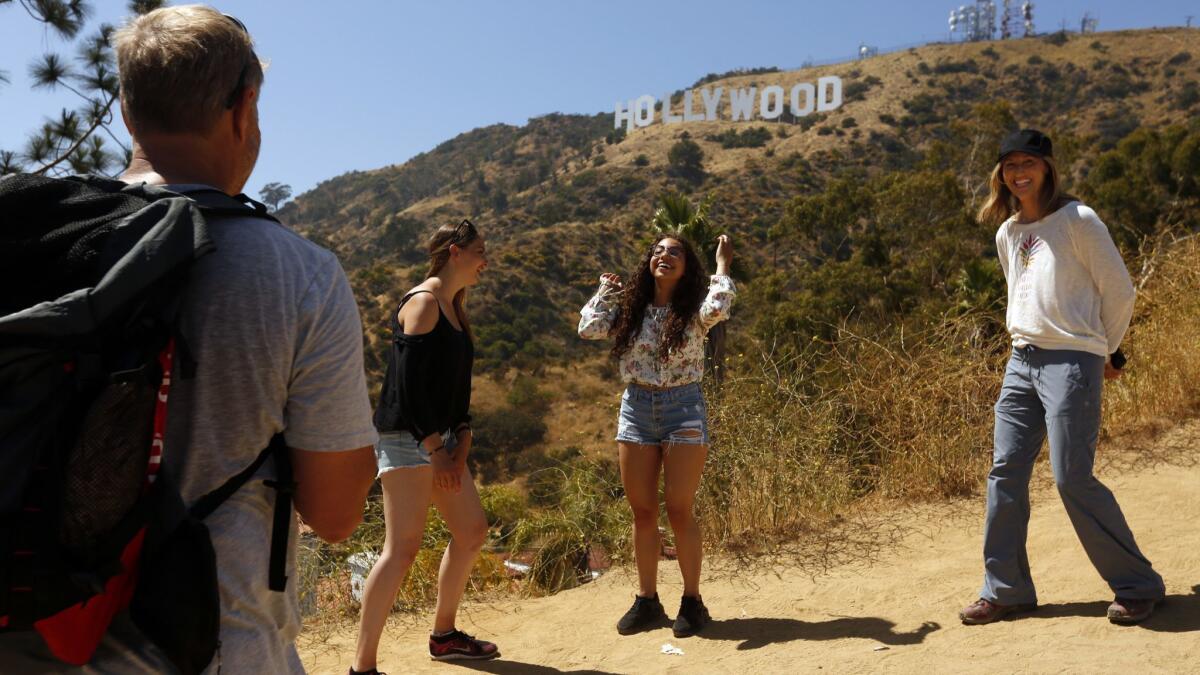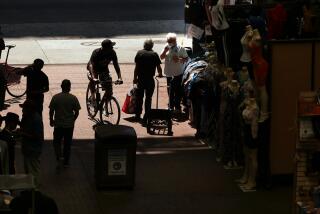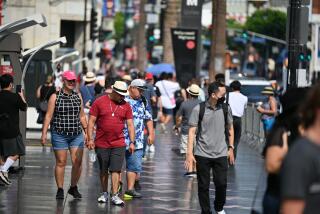Defying fears of a slowdown, tourists pumped $22.7 billion into the L.A. County economy

A record number of tourists injected $22.7 billion into the Los Angeles County economy last year, countering fears that a strong dollar and tough rhetoric from the White House might scare off international tourists.
The county hosted 41.2 million domestic visitors and 7.3 million international visitors in 2017, a 2.6% increase over 2016 — marking the seventh straight year of new highs, according to the Los Angeles Tourism & Convention Board.
Economists estimate the $22.7 billion of direct spending by visitors generated an overall economic effect of $34.9 billion when calculating the ripple effect on purchases of other goods and services. The direct spending total represented a 3.9% increase over 2016, according to the tourism board.
“We’re breaking tourism records year after year, because Los Angeles has always been a place that welcomes the world,” said Los Angeles Mayor Eric Garcetti, who has set a goal of drawing at least 50 million tourists a year.
Tourism statewide has also been on the rise. Visit California, the marketing venture for the state, reported this month that tourists spent $132.4 billion in the Golden State last year, up 3% from 2016.
About 40% of all tourism spending came from California residents, with an additional 37% coming from other states, according to Visit California. About 23% of tourists in California came from outside the U.S., a share that has been on the rise since 2011, according to Visit California.
The rise in visitors to Los Angeles County and the state coincides with the end of the recession in the U.S. and the strong economic recovery. Experts also attribute the increase in travel spending partly to low air fares — thanks to relatively cheap fuel costs — and investments in Los Angeles-area tourist attractions, such as the opening in 2016 of the Wizarding World of Harry Potter attraction at Universal Studios Hollywood.
To take advantage of the growth, the hotel industry in Los Angeles County has been on a building spree, with at least 700 hotel rooms under construction.
But tourism industry leaders have expressed fear that President Trump’s anti-immigration rhetoric and efforts to ban travel from several countries might send the message that the U.S. does not welcome foreign visitors.
In response to such concerns, the U.S. Travel Assn., a trade group for the country’s travel industry, has launched a coalition with other U.S. industries and travel groups, called Visit the U.S.A., to try to promote travel to the U.S. by international visitors.
In Los Angeles, Garcetti and other tourism officials were also worried last year about the effect of Trump’s harsh rhetoric. They launched a campaign to send a message of welcome to tourists, especially from Mexico and largely Muslim countries.
The campaign featured a music video that appeared on social media sites in Canada, China, Mexico, Britain and Australia.
There is good reason for the concerns. Tourism represents one of the largest employers in Los Angeles County, with more than 500,000 jobs supported by the leisure and hospitality industries.
So far, visitor numbers have remained strong and tourism officials say they are optimistic about the future.
“At this moment, we are still optimistic for 2018 and the next couple of years,” said Patti MacJennett, senior vice president at the Los Angeles Tourism & Convention Board. “But we are monitoring the political climate very carefully.”
She noted that visitation numbers from Mexico dropped 2.8% — a significant development because Mexico has been the biggest source of visitors to L.A. County.
The good news, MacJennett said, is that the numbers of visitors from China and Canada, the second- and third-largest sources of tourists to the region, have increased 11.7% and 5.5%, respectively.
Part of the reason for the increase in visitors from Canada, experts say, is that the U.S. dollar has fallen slightly in value compared with foreign currency, making travel to the U.S. less expensive.
National tourism promoters say the decline in visitors from one or two countries — such as Mexico — is not surprising, especially after several years of steady and record-breaking increases.
“We saw record visitation for six or seven years in a row, so you are going to see some moderation and corrections once in a while,” said Chris Thompson, president of Brand USA, the marketing organization created in 2010 to promote travel to the U.S.
He noted that a Brand USA survey in December in several foreign countries found that 81% of those questioned said they are likely to visit the U.S. in the near future — compared with 79% in a 2016 survey.
“A lot of the conversation early on, including doomsday predictions, have not materialized how everybody thought,” Thompson said.
Los Angeles County is not alone is reporting an increase in spending last year.
The Greater Palm Springs Convention & Visitors Bureau reported last week that tourists spent $5.5 billion last year in the area, a 10% increase over 2016. Tourism is the largest employer in the Palm Springs region, supporting nearly 52,000 jobs, according to the bureau.
To read more about the travel and tourism industries, follow @hugomartin on Twitter.
UPDATES:
4:25 p.m.: This article was updated with information about tourism statewide and in other regions.
This article was originally published at 9:55 a.m.







